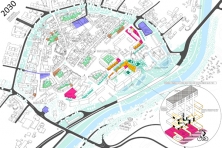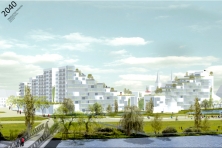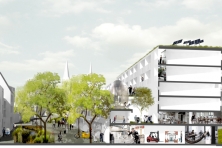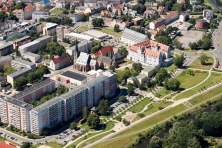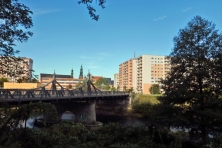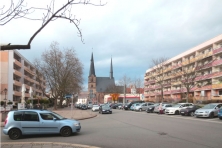PRODUCTIVE UPDATE
Zwickau (DE) - Lauréat
DONNÉES DE L’ÉQUIPE
Représentant d’équipe: Stephan Schwarz (AT) – architecte urbaniste
Associés: Ingrid Sabatier-Schwarz (FR), Ferdinand Schmelzer (DE) – architectes urbanistes; Lena Flamm (DE) – paysagiste
Collaboratrice: María del Rocío Díaz Marrero (ES) - architecte
Wilhelmine-Gemberg-Weg 14, 10179 Berlin (DE)
+49 152 52756988 – contact@isssresearch.com – isssresearch.com
Voir la liste complète des portraits ici
Voir la page du site en anglais ici

S. Schwarz, I. Sabatier-Schwarz, F. Schmelzer et L. Flamm
INTERVIEW en anglais
Cliquer sur les images pour les agrandir
1. How did you form the team for the competition?
We are currently sharing the same co-working space in Berlin, this is where we met again a couple of years after our graduation, since some of us have known each other from the university. Every one of us has different points of view in the field of urban planning, but the common ambition is to create better life conditions for the future unites us as a team. For Europan we were motivated to fertilize our multifaceted perspectives for a common project proposal.
2. How do you define the main issue of your project, and how did you answer on this session main topic: the place of productive activities within the city?
Zwickau needed new ideas and visions, on a larger scale, for its city centre, in particular the mono-functional residential units located in the Eastern part of the city, along the Mulde River. After visiting Zwickau and meeting up with members of the city council, it seemed evident to us that a soft and flexible long-term strategy was needed rather than a rigid classical master plan in order to address the challenges raised by the task in Zwickau. A long walk through the city and the project area showed clearly that the whole central part of the city has a huge unused potential, and that it simply required a productive update of the existing urban fabric. The main objective of our proposal is to infiltrate this existing urban landscape with new productive layers in order to create an intensified and more heterogeneous urban environment at a human scale. By urban landscape we address the current building structure as well as the connection to public spaces. This includes multi-coded spaces, with various functions: areas of recreation, urban habitat as well as urban production. With this strategy the city is reinterpreted as a heterogeneous interwoven place for living, working, producing and responding resiliently to future adaptations.
3. How did this issue and the questions raised by the site mutation meet?
The topic of the productive city fits perfectly with the aim of a more heterogeneous and vibrant city centre. Zwickau's tradition as an industrial city with a long history of engineering, car related enterprises and the presence of a technical University appears as a fertile basis for these transformations. In the next decades, mobility and individual transport will change radically due to digitalization and the need for new post-oil mobility patterns and driving technologies. Zwickau could distinguish its profile as a pioneer in this development and become a laboratory for those new technologies in a productive city. A heterogeneous and dense city at human scale will be both, cause and consequence of that development. Starting from that vision and looking at the present challenges of the site in Zwickau, we were very inspired by its historic relation to the river and the idea that the layers of working, producing and dwelling were historically strongly interwoven. In order to integrate all historic dimensions of the city into its future, it was clear to us, that we had to avoid a complete tabula rasa of the present situation, in favour of a proposal that fosters an approach integrating, transforming and adapting the existing buildings. Our productive update provides space for an intensified and productive urban life in a city of short distances with high quality of the urban spaces.
4. Have you treated this issue previously? What were the reference projects that inspired yours?
All team members draw from vast experiences in urban planning projects. These were made fruitful to create the visionary proposal needed for the city of Zwickau. For the different issues of our project, different projects were used as references. The idea for a radical, new and experimental mobility concept was the result of the inquiry of studies about the mobility of the future, for example the research of Future Cities Laboratory of ETH in Zürich. Based on our believes of the necessity of a processual approach and the intention to integrate the existing building stock, we were inspired by the radical simplicity of Lacaton Vassal's approach proposed in their study PLUS for the treatment of large scale residential buildings. Ideas for a more generous and natural treatment of the Mulde rRver were inspired by the renaturation of the Emscher River and the concept "Neckarhabitat" for a natural design of the Neckar River currently under construction for the BUGA Heilbronn 2019 by SINAI. What was also very important to us was an intense research phase on predictions and prognosis regarding future modes of productions, as well as, the role of nature as a dynamic system and an integral part of the productive city. Future visions and experimentations on how to use spatial, technological and infrastructural synergies for productive and vibrant urban sustainability are key aspects of our work. The question of how to create urban mix-used neighbourhoods integrating all dimensions of future daily life is an issue that we have been dealing with in a series of projects as well as in various teaching engagements before bringing together our different expertise for the challenge of Europan in Zwickau.
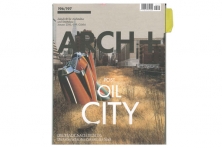
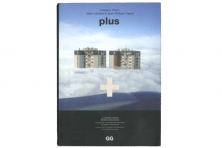
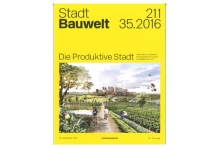
5. Urban-architectural projects like the ones in Europan can only be implemented together with the actors through a negotiated process and in time. How did you consider this issue in your project?
Considering that the upcoming decades will bring up innovations that cannot be predicted today we are convinced that a processual strategy is the right approach to tackle the challenges in Zwickau. Therefore, our project offers a long-term strategy that can be translated gradually in formal urban development plans. We worked on a very large scale addressing all related angles for an integrated transformation that can be implemented partly at different stages in the future development. We provide images of the future and propose a clear direction of relevant parameters and issues to be considered on the way towards a sustainable urban future for Zwickau. The whole project would span over three decades for a smooth and flexible implementation that would not overburden the inhabitants of Zwickau and the financial means of the municipality and will take shape as negotiation is being orchestrated between all actors.
6. Is it the first time you have been awarded a prize at Europan? How could this help you in your professional career?
Yes, it is the first time winning for all of us. Now we are very curious to see how being part of the Europan network will help our professional career. In our best-case scenario we are busy till 2050 accompanying the process of urban transformation in Zwickau.
